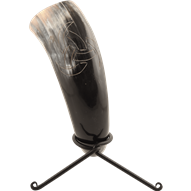 |
Yuletide |
| Long ago, the Germanic tribes of Northern Europe celebrated Yule instead of Christmas. This Old Norse midwinter festival has actually influenced some of today's holiday customs, from feasting and tree decorating to even jolly Santa Claus.
|
| | | |
|
A Midwinter Feast
Yule celebrations typically lasted for 12 days, which sounds a lot like the 12 Days of Christmas we remember now by the popular Christmas carol. Set around the winter solstice, where days become longer and nights grow shorter, the rebirth of the sun was central to the celebrations. During this festival, feasting was of top priority, often coupled with animal sacrifice. The star of the meal was the Yule Boar, over which vows were made with solemnity. This tradition survives in some way today as the Christmas ham, a popular item on the menu during modern holiday meals. Toasts were made to Odin for victory and other gods, Njordr and Freyr, for peace and good luck in the harvests to come. |
|
 |
|
Evergreen & Oak As their color did not fade in the cold, evergreen trees were revered as reminders that life would return even after the harshest winters. Ancient Norse people decorated these trees with carvings, food, and clothing as gifts for spirits, a tradition we see today echoed in modern Christmas trees hung with ornaments and surrounded by wrapped presents. Holly was also held sacred, another evergreen plant used to decorate the home both in early history and today.
The Yule log was another central aspect of the festivities, a massive oak tree trunk chopped down and carved with runes. It would be burned day and night throughout the festival as a symbol of the returning sun. Part of what remained afterward was used to light the new Yule log next year, and this Yule log leftover was said to help guard against illness and other misfortune.
|
|
| | |  Odin's Viking Drinking Horn with Stand View Item |
|
Jolly Old Odin
Both wise, bearded men from cold, northern lands, Odin and Santa Claus have much in common. The Santa we think of today is sort of an amalgamation of different folklore and religious origins, including Saint Nicholas and Father Christmas. Odin joins the ranks, as mythology describes him riding in the night sky on his eight-legged horse Sleipnir. He leads the Wild Hunt, a group of supernatural beings, elves, gods, or spirits of the dead. The Wild Hunt is often an omen of changing weather, which suits the solstice-centered festival. One folktale says that children could leave out boots filled with hay for Odin's horse, and he would in turn refill it with treats, much like how today children wait for Santa to leave them presents.
Many of the holiday traditions we think of today draw from a vast history spanning cultures and eras past. No matter how you enjoy this time of year, we wish you and yours good fortune and cheer for the end of this year and beginning of the next.
|
|
 |
|
| Help Box | Popular Categories | What's New | | | |